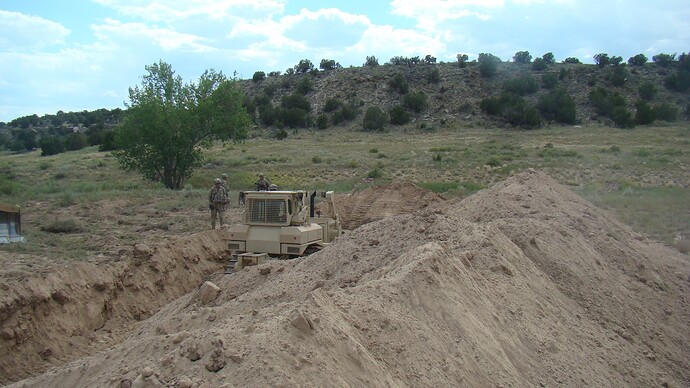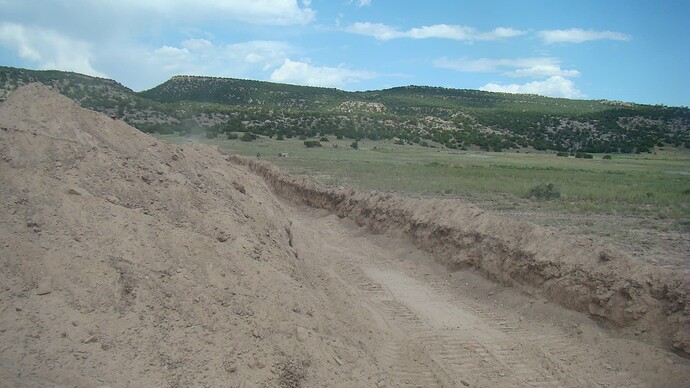H.P.
As these pics come from Facebook they may not stay for long. You can find them here
H.P.
Now if the kit makers would finally respond. The support units were always under appreciated and carried the load! The bridge unit in Kelly’s Heroes! Always amazed me people are so crazy about the most obscure stuff that the losers used, but neglect the equipment that helped win the war. HA HA Wayne
A few years ago I was an OC/T for an engineer unit at Fort Carson. During MDMP they decided the best course of action was to dig a three hundred fifty meter long tank ditch in a (to me) ridiculously short period of time. I wanted to say that even though it’s an exercise let’s try to be realistic here. But since I was there as a “TOC expert” and to help with MDMP, I decided to just not say anything. I’m glad I did. They had the thing completed ahead of schedule. Todd Hoffman (second Todd Hoffman reference this week) would have been envious.
Most of those “operators” on Gold Rush would be run off of most jobs I’ve worked on. Of course you have to make it look good for tv! Wayne
More from Facebook
Aussie forklift :
US one
H.P.
I’ve got to say that whenever I’ve come across Royal Engineers they have been working their bo**ocks off getting things done. Because of the role I did they were typically armoured or amphibious engineers sorting a crossing of an obstacle for armour.
Engr Recce were good to have as attachment as they had decent Night Vis kit so we used to get them stagging on in their CVRT as well ![]()
Yeah, you don’t realise how big Chieftain AVLB’s with a number 8 bridge on them are until you have to find a hide location for them and the AVRE’s with fascines on.
Great info posted up here. Researching the engineer support units and equipment when we did our FSB Ripcord museum dio was undoubtably some of the very hardest stuff to 'suss out.
Hugely underrepresented subject area for kit manufacturers. Consider something fairly simple like a set of figures with chainsaws and laying timber-cutting charges clearing an LZ or FSB. Maybe some guys surveying with a transit and stakes… Heck, how about a set of figures on a work detail filling sandbags and stringing up concertina wire. Would all be useful in many, many different scenes and for so many diorama compositions.
Just so much fresh stuff that could be done with this subject.
We used to wryly smile as the Armour and Infantry would get the plaudits for territorial gains and tactical victories.
No thought ever seemed to be given as to how they got there in the first place. I suppose those minefields just melted away, Moses parted the river for you and that anti-tank ditch breached itself eh mate?
First in, last out - an unofficial motto that the RE can be proud to say is true.
Is there a military in the world who doesn’t have to fill sand bags? That would be a great set to have.
Bravo 6 has Vietnam soldiers filling sandbags.

The US Army used the BLU-82, or Daisy Cutter with excellent results for this.
On a smaller scale, It only takes a few wraps of det cord (formula based upon diameter of trunk) which can be simulated with thin wire. The kicker (no pun intended) is modelling someone climbing the tree to place the one pound kicker charge near the top that is attached to the same det cord, so that you can fell the tree in the desired direction.
And let’s not forget there is a BLU-82 available in 1/35!
Yea, but we need a whole squad of guys filling and stacking 'em to do the job justice. These two sad-sacks look they’re just working time off the First Sergeant’s sh*t list… LOL!
Better that than the s**t burning detail! Wayne
True, but there’s lots and lots of film and stills of engineers dropped off from choppers with recon and initial infantry security platoons using chainsaws and timber-cutting charges to cut out / expand HLZs (especially in some of the situations where there were “longish” battles like Hamburger Hill, etc). The same process was usually just expanded to occupy FSBs. Clear the HLZs large enough for Chinooks or Sky Cranes to sling-load in the heavier equipment, like the M450 dozer, which was used to do the major work. Dozer all the slash out to the perimeter and then drop 55 gal drums of napalm on it from choppers, spark it all up and let it burn off.
(BTW, defoliant missions were also flown around the perimeters of most FSB to kill the trees and understory vegetation, which was again, burned off by controlled drops of naplam drums from low-flying choppers and then igniting it with thermite grenades also dropped from the same helos.)
A lot of larger bunkers were also framed up using heavy timber cut locally and put together at larger bases back in the rear and then moved by sling-load into prepared trenches cut with heavy equipment to be sand-bagged up by the occupying unit, and finally buried back over by the engineers. Bolt together corrugated culvert sections were used for all sorts of fighting positions and bunkers. CONEXs often fitted up in the rear for, say, commo or surgical support, and then sling-loaded again into prepared trenches to be “bunkered” in.
Once you start doing the math on the U-shaped pickets and rolls of concertina to make a triple-standard fence around the perimeter of even a small FSB only a couple of hundred of meters long or wide, and suddenly the engineering log support becomes astounding. Tons and tons of wire and pickets just for the minimum barrier requirements along with pallet loads of bundled up sandbags.
There was a lot more “tactical” engineering support that was done than I realized until I started digging into the subject a couple of years back. Unfortunately, there’re almost no scale model kits and figures to depict much at all of this.
When I was in Afghanistan I started a “Top ten reasons it’s good to be an SF guy in Afghanistan” video.
Never finished it as I ran out of juice where I was and couldn’t recharge the battery. Then I lost interest.
Notables were:
All the free Snapple you can drink (holding Snapple bottle)
Get to wear cool baseball caps.
Don’t have to salute officers. Unless you don’t like them. (sound of gun shot)
And one of them was, “You’re not this guy.” which showed the guy pulling the containers out, in his sandals no less.
Ah, the memories. And people wonder why physical hardship doesn’t bother me.



















